The Power of Parents
You’re the Key to Supporting Your Child’s Communication Development
As a parent, you help your child learn new skills every day. Communication skills are no different!
★
Let’s take a closer look at how you can transform the routines and activities you already do with your child into the best possible opportunities for them to learn and practise communication.
Why Are Parents so Important in Supporting Children's Communication?

Research shows that you are the ideal person to build your child’s early communication skills because:
- You spend the most time interacting with your child.
- Your child is most comfortable communicating and interacting with you.
- You know your child’s interests and preferences that will make interactions motivating and fun.
- You can use communication strategies naturally throughout your child’s day – so your child is learning in situations that are meaningful to them.
If you are concerned about your child's language development, working collaboratively with a speech-language pathologist will enable you to learn to use research-based strategies that have been shown to help children develop improved communication and language skills. This is true for all children with language difficulties, including children who are on the autism spectrum or children with developmental disorders.
Read more about what the research says about parent involvement in early language intervention.
How to Start – Identify Your Child’s Stage of Communication
The first step to supporting your child’s communication development is to recognize what they already do. This will help you identify your child’s current
Stage of Communication.
The Hanen Centre’s research-based
It Takes Two to Talk® parent program organizes children’s early communication development into four stages:
Discoverer, Communicator, First Words User and
Combiner. Each stage includes the reasons
why your child communicates,
how your child communicates, and
what they understand. You can find more information about the Stages of Communication in the
It Takes Two to Talk® parent guidebook.
Read about the main feature of each stage:
Discoverer Stage
-
Your child is at the Discoverer Stage if they react in different ways (e.g., cry, smile, make sounds, move their body) to how they feel and what is happening around them, but do not yet communicate with a specific purpose in mind.
Communicator Stage
-
Your child is at the Communicator Stage if they communicate specific messages directly to you or others without using words (e.g., sending messages with facial expressions, sounds, looks, and/or gestures).
First Words User Stage
-
Your child is at the First Words User Stage if they intentionally use single words, signs, or pictures to communicate.
Combiner Stage
-
Your child is at the Combiner Stage if they intentionally put two to three words and/or signs together to communicate.
Strategies to Build Communication at Each Stage
Knowing your child’s Stage of Communication will give you a good idea about the next steps in their development. The
It Takes Two to Talk® parent guidebook provides many practical ideas and strategies for supporting your child’s communication skills at each stage, and for helping them progress to the next stage.
Your child learns best when they are engaged in enjoyable back and forth interactions with the most important people in their lives. See below for a
practical strategy you can use for each stage of communication.
Discoverer Stage
-
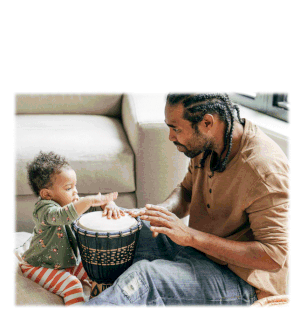
Interpret your child’s looks, sounds, and actions
Interpreting your child is a powerful strategy to let them know that you are interested in what they are feeling or doing. When you interpret your child’s looks, sounds, and actions as if they are communicating something specific, it helps them understand that what they do has an effect on others. In time, your child will start to do these things on purpose and that’s the beginning of intentional communication.
How to Interpret:
Step 1: Observe, Wait and Listen™ to see what your child is interested in or reacting to. Your child may react by moving their body, using facial expressions, looking around, reaching towards, and/or making sounds.
Step 2: Think about what your child might be feeling and wanting to communicate. This may mean taking your best guess based on what you know about your child and the current situation.
Step 3: Put into words what you think your child is trying to tell you. Use short, grammatically correct sentences, then wait to see your child’s reaction.
Communicator Stage
-
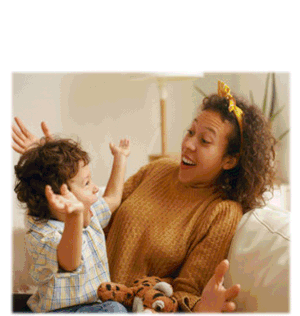
Join In and Play Using Fun Sounds and Words
Following your child’s lead by Joining In and Playing is a great way to show your child you are interested in what they are doing and communicating about. Joining In using fun sounds and words that match your child’s interests makes it easier for them to understand what you are saying. For example, you might use the fun word, “pop!” if your child is playing with bubbles or the fun sound, “moo!” if your child is playing with a toy cow. Because these sounds and words include an excited voice, gestures, and facial expressions, they are fun to hear, and your child may be motivated to try and use them too!
How to Join In and Play Using Fun Sounds and Words
Step 1: Observe, Wait and Listen™ to see what your child is interested in or what they might want to send a message about.
Step 2: Wait for your child to send you a message.
Step 3: Follow your child’s lead. Join In and Play the way your child is playing. While you play, use fun sounds or words and lots of animation in your voice to keep the interaction interesting. Add a gesture to your fun sound or word and wait for your child to take another turn.
First Words User Stage
-
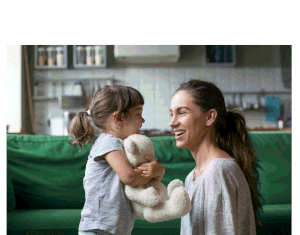
Highlight and Repeat Your Language
How you talk to your child makes a big difference in helping them learn language. When you Highlight and Repeat your language, you make the important words stand out, so that it’s easier for your child to understand and use the words when they’re ready. Children need to hear words repeated many times in many different situations to understand the meaning of the word and then to use the word themselves.
How to Highlight and Repeat Your Language with the Four S’s:
- Say less – use short, grammatically correct sentences.
- Stress the important words by saying them slightly louder or changing the tone of your voice.
- Go Slow – give your child time to process and respond to what you said.
- Show – use actions, gestures, sign language or pictures to help your child attach meaning to what you said.
- Repeat the important words 3 -5 times during your interaction and in other situations throughout the day.
- Don’t ask your child to say the word or expect them to use it right away.
Combiner Stage
-
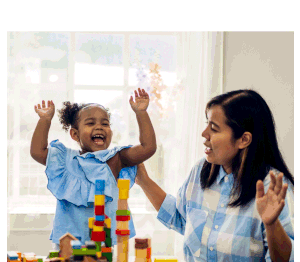
Expand Your Child’s Message
Once your child is combining words and/or signs together, you can help them speak in longer and more complete phrases by expanding on their message. When you expand on what your child communicates, you provide a model of the full meaning of their message.
How to Expand on Your Child’s Message:
Expanding your child’s message means that when your child says something, you respond with a slightly longer sentence, always including the word or words your child has said.
That’s why it is called “Expanding”. Your sentence becomes an expanded or a more complete version of what your child has said. For example, if your child points to their doll and says, “Baby seep”, you can expand by saying, “The baby is sleeping”.
When your child is at the Combiner Stage, you should try to expand every time your child communicates, as this is the most important way you can help your child express themself.
Articles for Each Stage
Here are some helpful links to research-based, practical information you can use to get started supporting your child’s communication. Refer to the Stage of Communication that best matches your child’s skills for suggestions that are relevant to you:
Discoverer Stage
-
A big developmental step happens when young children learn to send messages intentionally – that is, when they learn to communicate directly to someone to achieve a specific goal. Find out what parents of children with communication delays can do to encourage their child’s intentional communication.
|
Did you know that the way you position yourself when interacting with your child can make a big difference in how much they understand and communicate? Here are some tips you can use to make the most of face-to-face time with your child to help build their communication skills.
|
Did you know that interaction is the most important foundation for your child’s language learning? Learn how to engage your child in the kinds of back-and-forth interactions that set the stage for the best language learning.
|
Why is fun so important for language learning? Learn how to support your child’s communication by having fun interactions with them using these 6 practical tips.
|
Communicator Stage
-
Why is fun so important for language learning? Learn how to support your child’s communication by having fun interactions with them using these 6 practical tips.
|
The ability to use gestures is an important precursor for language development. Children who produce more gestures early on have been shown to have larger vocabularies and better story-telling abilities later on. Find out what you can do to encourage your child’s gesture use during everyday interactions.
|
To learn language, young children need to do much more than just hear you use words. What does an "early conversation" look like, and how can you make sure you're having them with your child as often as possible?
|
Learning to talk starts long before a child says their first words. There are many things your child needs to learn before they’re ready to use words. Here are some of the building blocks for using words, and tips for encouraging them with your child.
|
First Words User Stage
-
It's natural to simplify our language when speaking to children who are just learning to talk. But is it possible to simplify language too much? See what the research says about the kind of language that works best to help children learn.
|
By age 6, children understand about 10,000 words! This amazing feat happens by children following patterns in the language they hear every day. In this article, we share some tips on how you can help your child find patterns during your everyday interactions.
|
Children with language delays often need extra help to develop an understanding of a new word and to be able to use that word on their own. Here are some tips parents can use to make word learning easier for their child.
|
If your child is just starting to talk, you might be wondering how you can help them learn new words. Here are some tips for how you can identify words that your child will be motivated to learn.
|
Combiner Stage
-
If your child is just starting to talk, you might be wondering how you can help them learn new words. Here are some tips for how you can identify words that your child will be motivated to learn.
|
First words are exciting, but a child’s first combination of words is also important. Research shows that children who are late to combine words are at risk for future difficulties with language. Learn how to help your child combine words.
|
Combining words is a big step that allows children to express more than one idea at a time, and it becomes easier to figure out what they’re trying to tell you. Find out how early sentences develop and when to expect your child to start using them.
|
Combining words may happen a bit later for children with language difficulties. Learn some specific ways you can talk to your child to encourage this big step in language development.
|
Programs and Resources for Parents
The Hanen Centre has developed
five programs for parents. Led by a certified speech-language pathologist, these comprehensive, research-based programs help
you help your child. You will learn to create and take advantage of everyday opportunities to improve your child’s communication skills. Each program also has an associated guidebook that may be used during the program, while waiting for a program, or on its own. Find out which Hanen Program
® may be right for you:
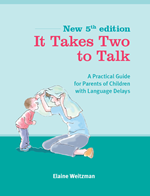 |
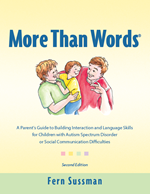 |
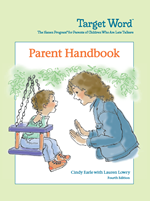 |
| It Takes Two to Talk® |
More Than Words® |
Target Word™ |
The Hanen Program® for Parents of Children with Language Delays
Program
Guidebook |
The Hanen Program® for Parents of Children who are on the Autism Spectrum
Program
Guidebook |
The Hanen Program® for Parents of Children who are Late Talkers
Program |
| |
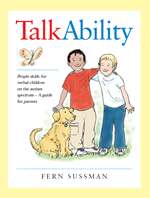 |
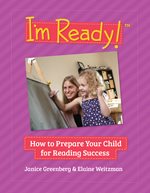 |
|
| |
TalkAbility™ |
I'm Ready!™ |
|
| |
The Hanen Program® for Parents of Older Children who are on the Autism Spectrum
Program
Guidebook |
The Hanen Program® for Building Early Literacy at Home
Program
Guidebook |
|
If your child is on the autism spectrum, or if they have social communication difficulties, visit our
Autism Corner for information and tips!
Are you a professional who works with young children with language delays/disorders and their families?
Handout
Share this handout with parents to help them understand the powerful role they can play in their child’s early language intervention.
e-Seminars
Explore the following e-Seminars for clinically relevant information to help you engage parents in their child’s early language intervention:
Certification workshop
The It Takes Two to Talk® workshop for SLP/Ts provides an evidence-based framework for coaching parents of young children with language delays/disorders to facilitate their child’s language development during everyday interactions and activities. You receive a license to offer the It Takes Two to Talk Program and to use It Takes Two to Talk materials in your 1-1 parent coaching sessions.
|
References
- Curtis, P. R., Kaiser, A. P., Estabrook, R., & Roberts, M. Y. (2019). The longitudinal effects of early language intervention on children's problem behaviors. Child development, 90(2), 576-592.
- Heidlage, J. K., Cunningham, J. E., Kaiser, A. P., Trivette, C. M., Barton, E. E., Frey, J. R., & Roberts, M. Y. (2020). The effects of parent-implemented language interventions on child linguistic outcomes: A meta-analysis. Early Childhood Research Quarterly, 50, 6-23.
- Roberts, M., & Kaiser, A. (2011). The Effectiveness of Parent-Implemented Language Intervention: A Meta-Analysis. American Journal of Speech-Language Pathology, 20, 180–199.
- Sangster, K. (2018). Critical Review: Does Parent-Implemented Early Intervention Improve Language Outcomes in Preschoolers with Language Impairments? University of Western Ontario. https://www.uwo.ca/fhs/lwm/teaching/EBP/2017_18/Kennie%20Sangster.pdf
- Sone, B. J., Lee, J., & Roberts, M. Y. (2021). Comparing instructional approaches in caregiver-implemented intervention: An interdisciplinary systematic review and meta-analysis. Journal of Early Intervention, 43(4), 339-360.
- Zhao, B., Liu, Y., Liu, J., & Liu, Y. (2022). Early Family Intervention in Children with Language Delay: The Effect of Language Level and Communication Ability. Evidence-Based Complementary and Alternative Medicine, 2022.